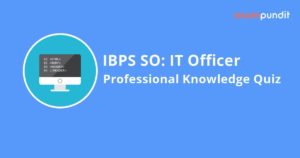Hello and welcome to exampundit. Here is a set of IBPS SO IT Officer Professional Knowledge Quiz on Networking for IBPS IT Officer Mains exam 2018.

- Which of the following technique is used for fragment?
(a) a technique used in best-effort delivery systems to avoid endlessly looping packets
(b) a technique used by protocols in which a lower level protocol accepts a message from a higher level protocol and places it in the data portion of the low level frame
(c) one of the pieces that results when an IP gateway divides an IP datagram into smaller pieces for transmission across a network that cannot handle the original datagram size
(d) All of these
(e) None of these
- What part of 192.168.10.51 is the Network ID, assuming a default subnet mask?
(a) 192
(b) 192.168.10
(c) 0.0.0.5
(d) 51
(e) None of these
- Which of the following statements is correct for the use of packet switching?
(a) the subdivision of information into individually addressed packets in conjunction with alternative routing arrangement enabled the transmission path to be altered in the event of congestion or individual link failure
(b) the employment of additional intelligence within the network enabled more sophisticated error control and link control procedures to be applied
(c) by employing wide bandwidth circuits for the trunk networks substantial economies through extensive sharing of capacity could be achieved.
(d) All of these
(e) None of these
- The research and development department at your office has been experimenting with different technologies to help improve the performance of the network. One group has been examining the use of a broadband network versus a based band network. Select the correct statement about broadband and baseband.
(a) Broadband networks carry several channels on a single cable, whereas in a baseband network several cables carry one channel
(b) Baseband networks carry a single channel on a single cable, whereas broadband networks carry several channels on a single cable
(c) Baseband refers to local area networks, and broadband refers to wide area networks.
(d) Baseband operates at a standard bit rate, whereas broadband may operate at different rates as needed
(e) Broadband and baseband refer to the different frequencies at which infrared operates then transmitting signals in certain conditions
- A network consists of eight NT servers. You are planning to move servers to different segments of your network, what utility should be used at each server to determine which server generates the most traffic?
(a) NBTSTAT
(b) NETSTAT.EXE
(c) Performance Monitor
(d) Network Monitor
(e) ARP.EXE
- You are working with a network that has the network ID 192.168.10.0. What subnet should you use that supports up to 25 hosts and a maximum number of subnets?
(a) 255.255.255.192
(b) 255.255.255.224
(c) 255.255.255.240
(d) 255.255.255.248
(e) 255.255.255.252
- Which of the following best illustrates the default subnet mask for a class A,B, and C Network?
(a) 0.0.0.0, 0.0.0.1, 0.0.1.1
(b) 255.255.255.0, 255.255.0.0, 255.0.0.0
(c) 255.0.0.0, 255.255.0.0, 255.255.255.0
(d) 255.255.0.0, 255.255.255.0, 255.255.255.255
(e) None of these
- You are working with three networks that have the network IDs 192.168.5.0, 192.168.6.0, and 192.168.7.0. What subnet mask can you use to combine these addresses into one?
(a) 255.255.252.0
(b) 225.255.254.0
(c) 255.255.255.240
(d) 255.255.255.252
(e) None of these
- What part of 172.16.3.1 is the Network ID, assuming a default subnet mask?
(a) 172
(b) 172.16.3
(c) 0.0.0.1
(d) 51
(e) None of these
- With an IP address of 100, you currently have 80 subnets. What subnet mask should you use to maximize the number of available hosts?
(a) 192
(b) 224
(c) 240
(d) 248
(e) 252


